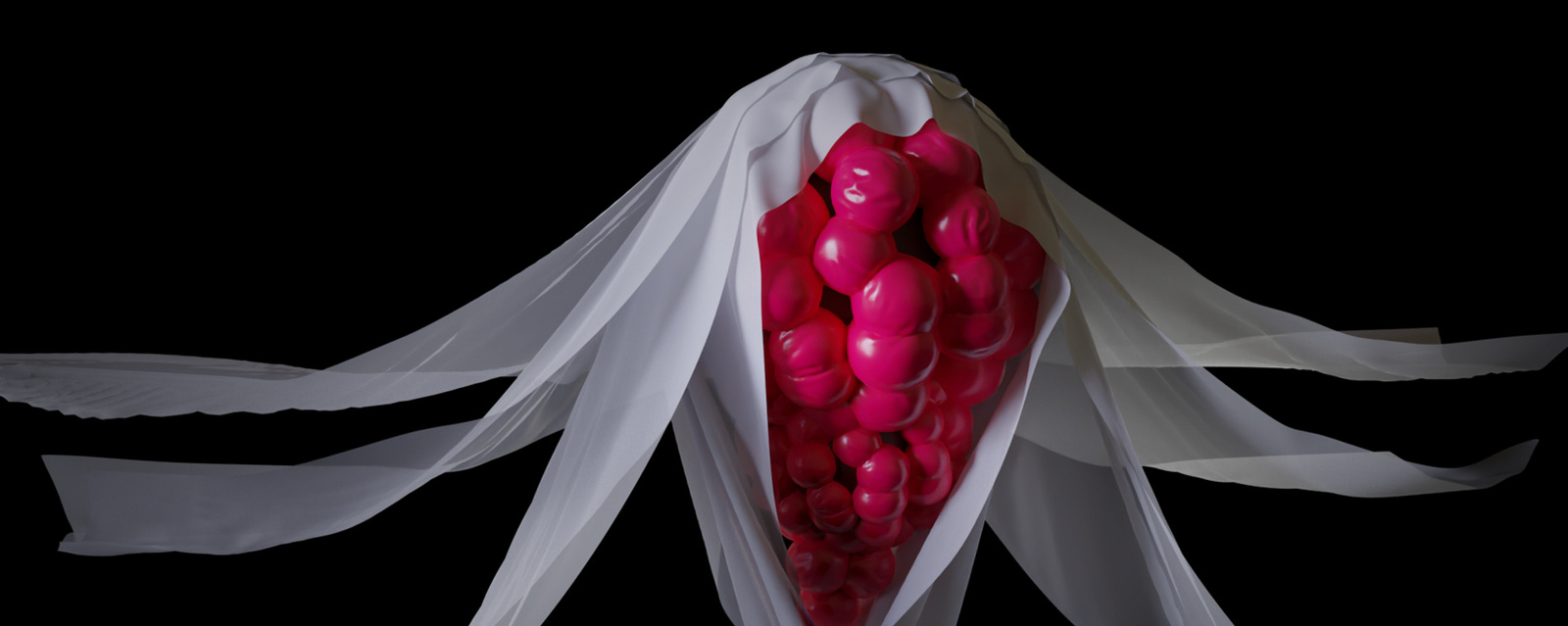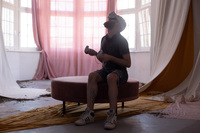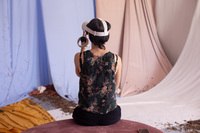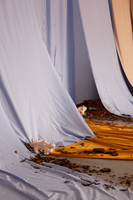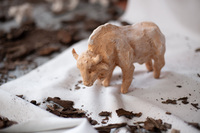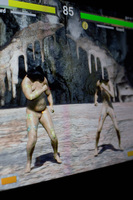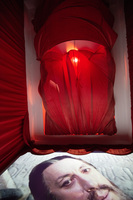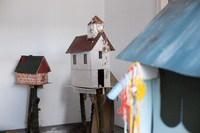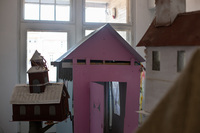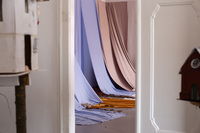In this project, Barbara Gryka is collaborating with a VR creator Agata Konarska.
The joint effort begins with the question of whether it is possible to build happiness in reference to a vision of an idealistic city by the Renaissance philosopher Tommaso Campanella. The goal of this utopian idea, known as The City of The Sun, was to describe the system, in which human life would be as close to nature as possible. Furthermore, the artists asked children who had to leave Ukraine due to war about the ideal place to live.
During the exhibition, we can experience a virtual adventure of exploring urban space which consists of 3D scans of bombarded Ukrainian buildings overlaid with the textures of the children's houses created during the workshops. The rain has passed, and colourful cardboard architecture is still sagging under the weight of water but the houses are drying in the sun with their creators’ messages hidden inside. These hopeful designs can be explored on the backs of animals: bison, lynx, stork and eagle. On the one hand, their symbolic meaning refers to East mythology, but on the other, we have national symbols that stimulate the forming of nations’ identities and uphold them.
Qualities related to bravery, strength, courage, but also fertility and increasing the size of the nation are being glorified in these types of attributes. They reduce the men’s role to fighting and women’s to childbirth. Symbols are used to strengthen the stereotypes and division; and to persuade the people that the nation is the greatest value and the most important form of society. This kind of thinking normally leads to not only the desire to win but also to domination and in consequence to provoking aggression towards another.
Is it possible to create a place in which several nationalities are able to live in total peace, beyond all divisions?
According to the artists, our goal right now is to have an impact on our future, which will be accompanied by catastrophic notes of the military, energy, migration and climate crisis. By accepting responsibility for future generations, they are leaving the field clear for children. Their abstract imaginations about a place in which we can all feel good transform into art. The joint activities are an inspiration for the new architecture that is based on qualities like intuitiveness and naivety. Children’s vision of an ideal city manifests itself in things that adults do not notice. It becomes a mirror, in which issues of nationality, patriotism, human kindness and the relativity of happiness reflect.
Barbara Gryka
- originally from the Polish village of Końskowola. She is a graduate of the Faculty of Media Art at the Academy of Fine Arts in Warsaw. In 2019, she received her diploma from the Studio of Spatial Activities of Mirosław Bałka. Currently, she is a doctoral student at the Sound Action Space Studio, led by Katarzyna Krakowiak, PhD, at her alma mater. Her practice deals with performative actions. She works with people who are not necessarily involved in art. Her favourite pastime is conversing, and she also enjoys observing other people, their behaviour and lifestyles. In the "Architecture from the Inside" project, she visited her neighbours in the Lublin Housing Association, knocking on their doors and asking to have a chat. She plans to continue visiting modernist Polish apartment blocks. In the "Dance of the Motorcycles", she led a group of eight men on motorbikes who danced a Lublin folk dance.
Agata Konarska
- born in 1995, she is a graduate of Intermedia at the UAP (2018) and the Faculty of Media Art at the Academy of Fine Arts in Warsaw (2023). Her artistic activities are based on the use of various media, such as video, sound and performance, through which she creates interactive situations and creates virtual realities. In her work, she touches upon the subject of religiousness, oscillating between the sacrum and profanum. She explores the phenomenon of the iconicity of women, searching for the anthropological genesis of the matriarchy and its references in the Anthropocene era. She often uses political, geological and animalistic motifs. She is fascinated by contemporary myths and rituals and the imminent apocalypse. She notoriously dreams of animal hybrids and the spaciousness of architecture.
- Exhibition
- 24 June ‒ 4 August 2023
- artist: Barbara Gryka, Agata Konarska
- curator: Agata Cukierska, Katarzyna Kalina
- opening: 24.06 (Saturday), 7:00 - 9:00 p.m.
- DJ set:: Pastwa, 8:00 p.m.
- visual identity: Marcin Wysocki
- photo documentation: Barbara Gryka, Marcin Wysocki
- tickets: 1 PLN (reduced), 3 PLN (regular)
